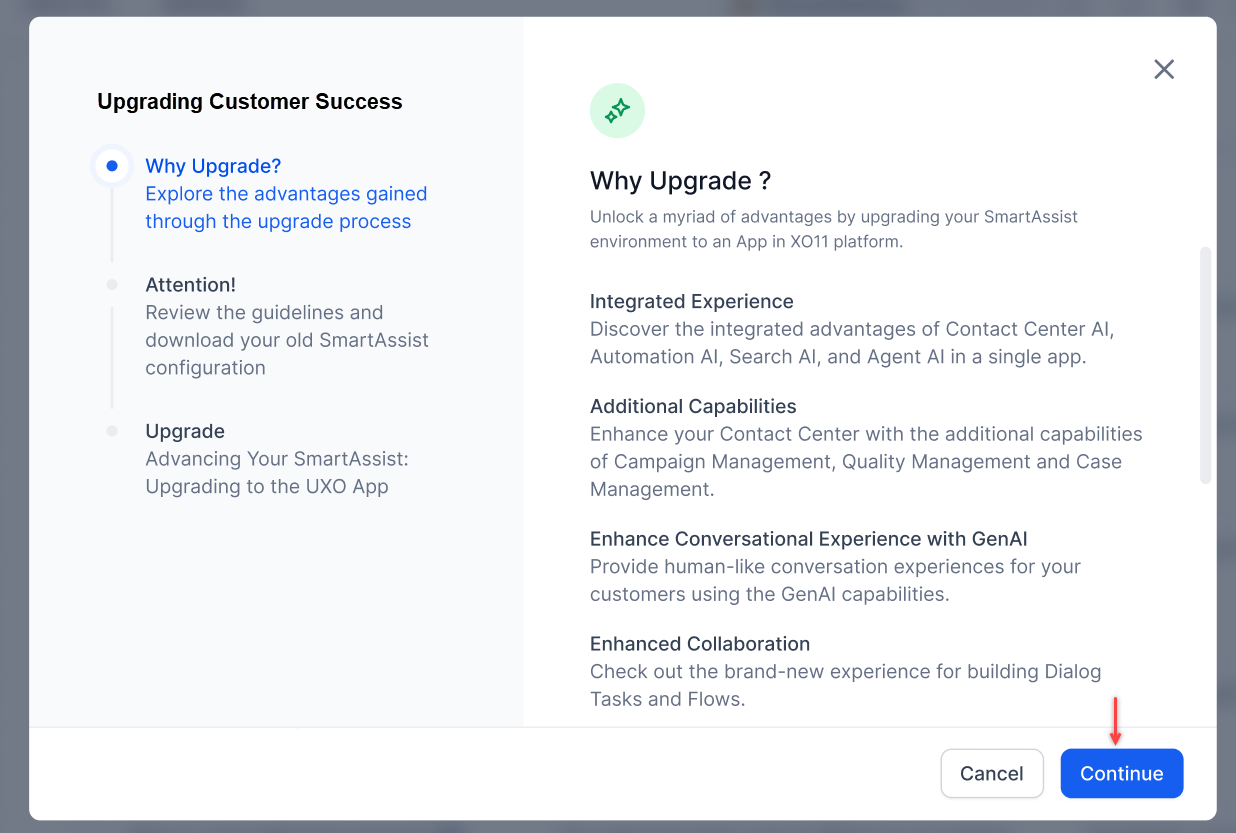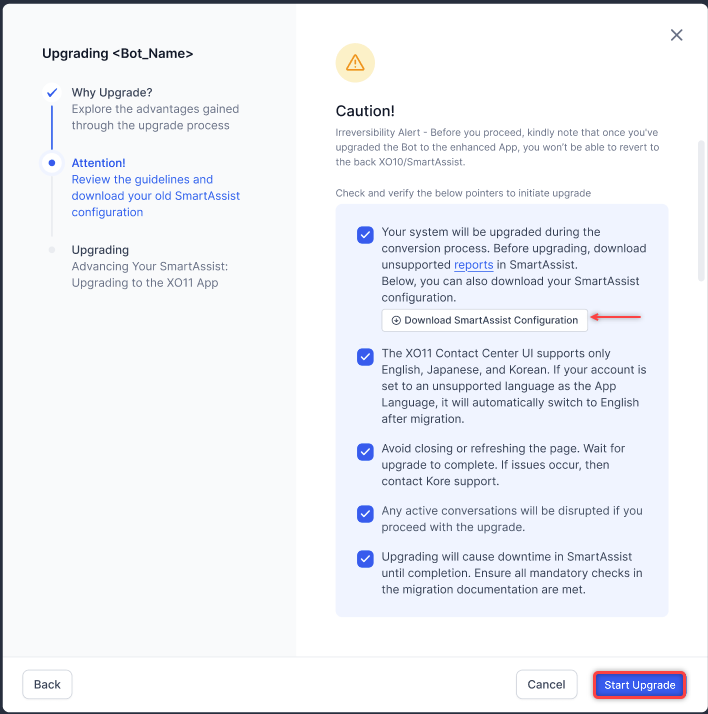Overview
This guide provides step-by-step instructions on upgrading your SmartAssist account to the new XO11 platform. The upgrade process includes a streamlined transition to XO11.
Why Upgrade to XO11?
- Integrated Experience: Integrated advantages of Contact Center AI (CCAI), Automation AI, Search AI, and Agent AI in a single app.
- Additional Capabilities: Enhanced Contact Center with additional capabilities in Campaign Management, Quality Management, and Case Management with additional top-ups.
- Access to Agent AI and Search AI will be available to authorized users based on additional licenses.
- Enhanced user experience for the Agents and Supervisors.
- Improved conversational experience and human-like conversations using the GenerativeAI capabilities.
- Enhanced Collaboration: Brand-new experience for building Dialog Tasks and Flows.
- SmartAssist is nearing its end of life. The XO11 platform will be used to develop all the new features in the Contact Center.
Prerequisites
- A valid SmartAssist account.
- The user with Bot Owner access can only upgrade the SmartAssist account.
Pre-Upgrade Checklist
- Download reports which are not supported in the XO11.
Agent Login Logout Details Report – If you need data from this report, go to SmartAssist, rerun the report before the upgrade, and download the reports. - Learn about changes and enhanced features.
- Inform your SmartAssist users of the new upgrade and downtime.
- During the upgrade, they will be terminated if there are any active conversations on all channels (or wait for them to taper off).
- All other data (in Reports, Dashboards, etc.) will be preserved.
What Will Change
Bot to an App in the XO11 platform
The bot system is transitioning to a consolidated app in the XO11 application. SmartAssist Instance bot and child bots will become individual Apps on the XO11 platform.
Workflow Migration
All existing workflows will be transferred to their current state. Flows containing deflection nodes will be maintained during the transfer but with a renewed experience. Conversational Input and Run Automation have been combined.
User and Role Migration
User migration will align with the user management framework. All current roles will be transferred directly. SmartAssist roles will be recreated as custom roles maintaining identical permissions, with the naming convention: {roleName}_{instanceBotName}.
Use Case Handling
After the upgrade, configurations made in use cases in SmartAssist will work as before in the XO11 platform, but the dialogs will not be visible. If you want to make any changes, contact the Kore support team.
Agent Transfer Settings
Agent transfer configurations will be preserved and implemented at the application level.
Default Flow Changes
The existing default flows (such as “no agents available” and “out of hours”) that were previously accessible from the left navigation menu are discontinued, as dedicated flow types have now been implemented for these scenarios.
New/Changed Reports
- Agent Entry-Exit Summary Report (New Report) -This report will not contain login/logout events but will include the Agent’s app entry and exit events.
- Agent Activity Summary Report (Changed Report): This report will no longer contain the first login and last logout fields; instead, it will include the agent’s App Entry and Exit fields.
- If you need reports with previous columns, rerun them in SmartAssist before upgrading to XO11. After the upgrade, these reports will be run with new columns.
Billing Structure Change
Billing structure changes for different user categories:
- Enterprise users convert to XO11 Enterprise standard (includes Automation AI, Contact Center AI, Basic RAG Search AI, Basic Agent AI).
- Non-Enterprise Free users receive an XO11 trial version for Automation AI and Search AI, with a “Try now” option for Agent AI and Search AI.
- Non-Enterprise paid users ($10>) receive an XO11 trial version for Automation AI and Search AI, with a “Try now” option for Agent AI and Search AI.
Important Points
Upgrade Access Impact
The upgrade process is irreversible and accounts upgraded from SmartAssist to XO11 cannot be reversed to their previous state. In case of an error during the upgrade, the process is reverted automatically and users will continue to have access to SmartAssist.
Localization
The XO11 Contact Center UI only supports English, Japanese, and Korean. Following migration, users who have selected any other language as their App Language will automatically be switched to English.
Audit Trail Requirements
- The system creates records in Audit Events when an upgrade is initiated.
- Upgrade status updates are tracked throughout the process.
Role-Based Access Control
- Upgrade privileges are restricted to bot owners only (for both SmartAssist Instance and child bots).
- After the upgrade, agents and supervisors receive notifications about platform upgrades.
- Users can use existing credentials to access the XO11 platform.
- Agents and supervisors will be redirected to the new platform for content center operations.
Upgrade Journey from SmartAssist to XO11
Upgrade Notification
Steps to initiate the upgrade to XO11:
- Log in to SmartAssist > Configurations. A notification is displayed at the top of the screen.

- The following options are available:
- Learn More: Redirect to XO11 Documentation.
- Go to new XO Platform: Redirect to the XO11 Platform.
- Click Go to new XO Platform to initiate the upgrade.
- Login to XO11 using your SmartAssist credentials.
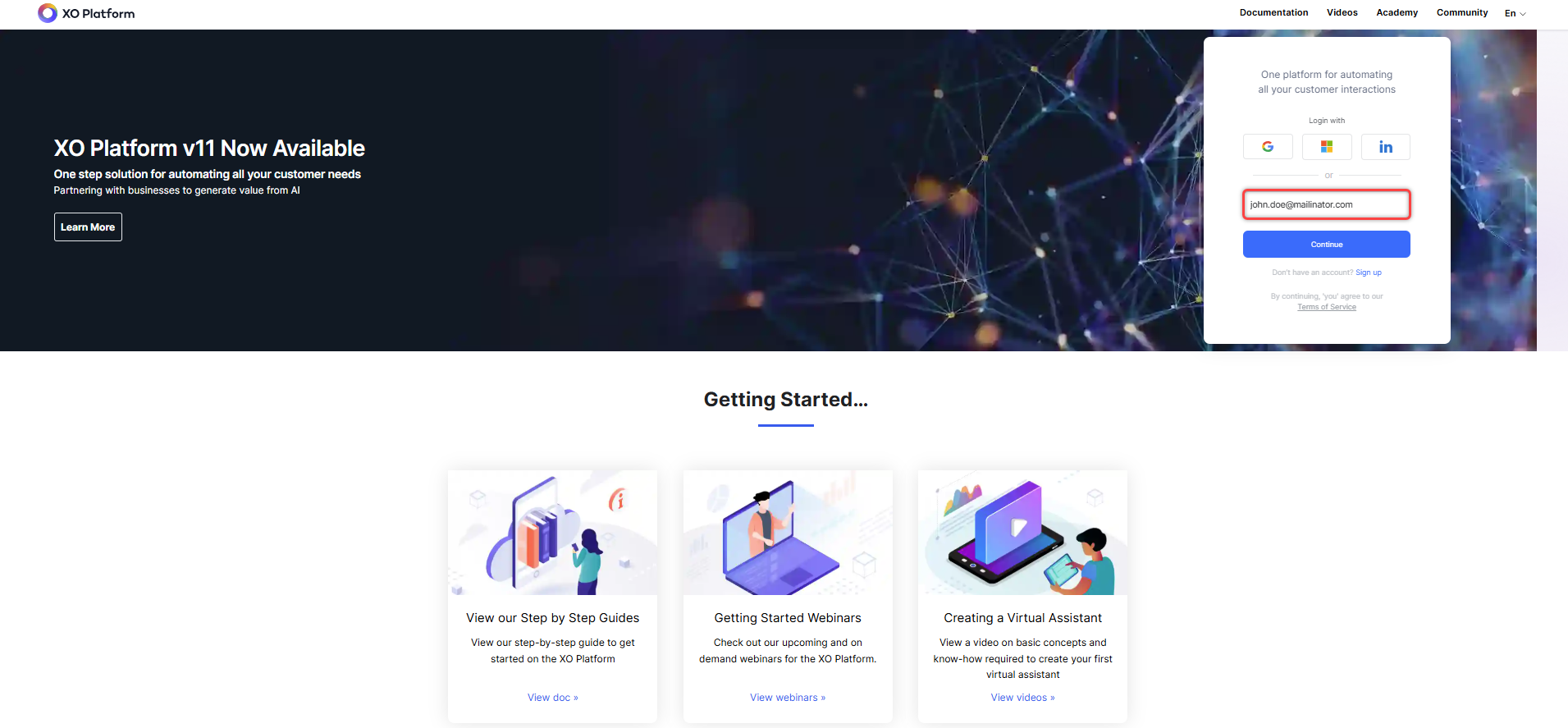
- All apps (SmartAssist and automation bots) are displayed. Click the SmartAssist bot to upgrade to an App in XO11.
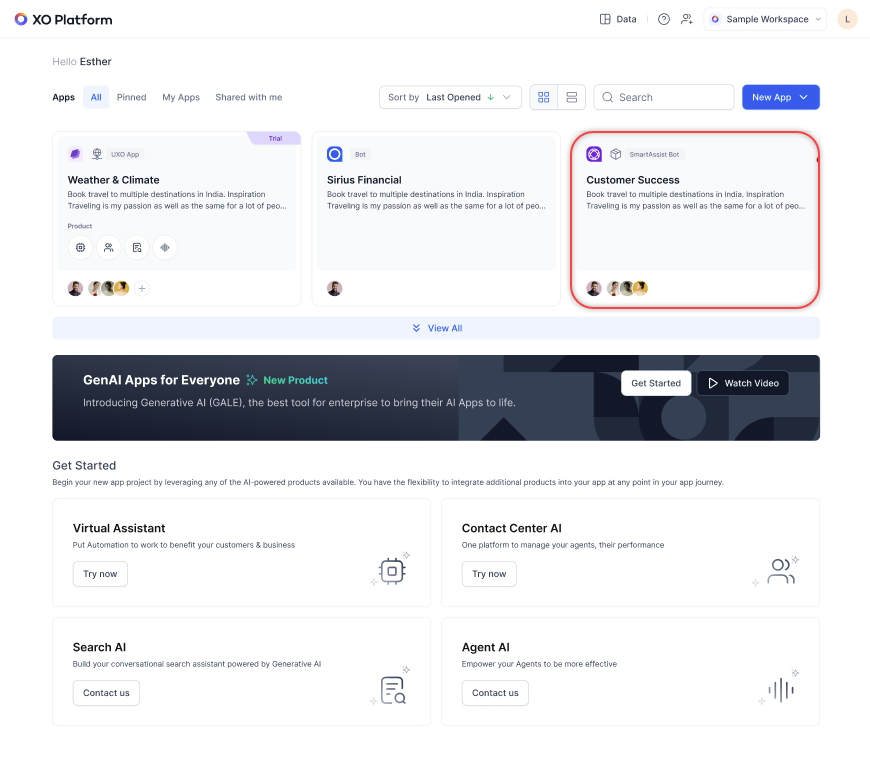
- A pop-up appears with the following options:
- Review and check the guidelines, download your SmartAssist configuration, and click Start Upgrade. The following configuration data is downloaded:
- Instance-bot configurations.
- Agent-related information (for example, agent mapping to queues and agent groups).
- Experience flow and channel configurations
- All contact center settings, including:
- A progress bar is displayed. Click Finish on completion.
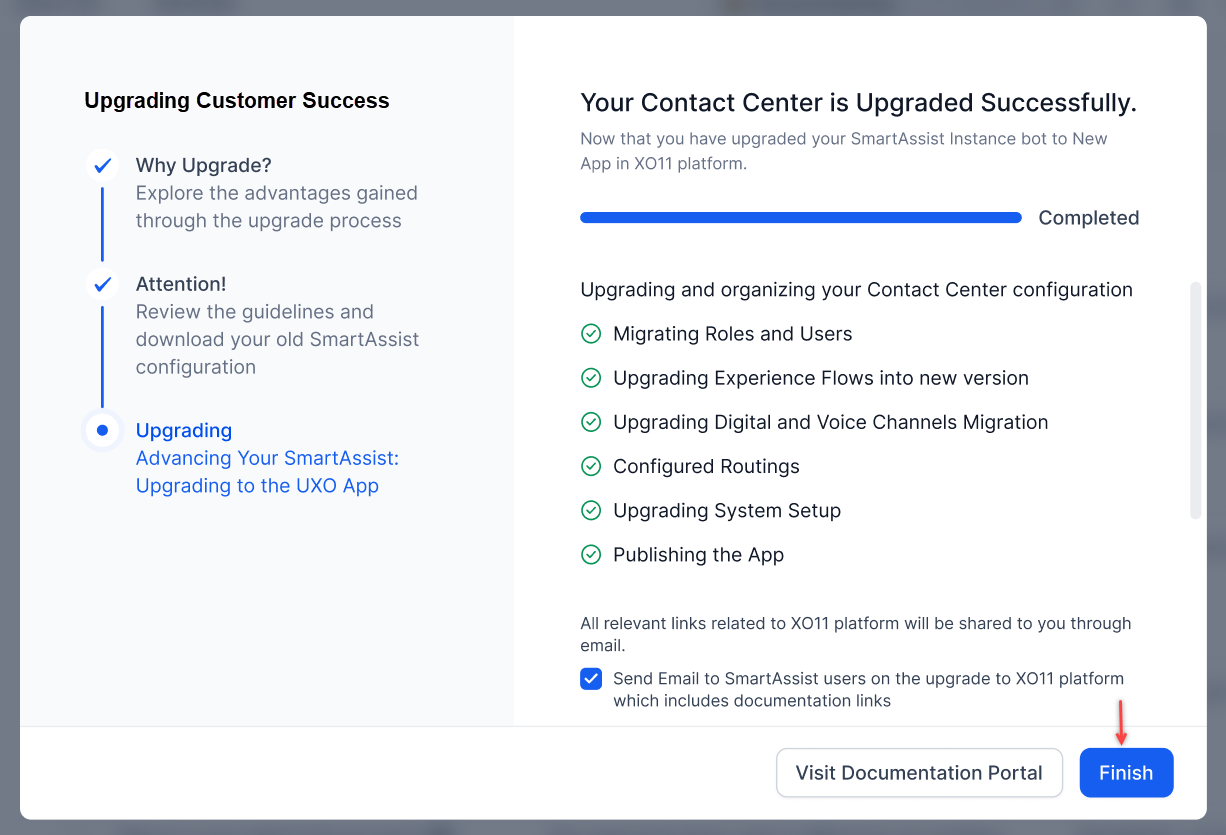
By default, the Send Email to SmartAssist users option is selected. When the app owner clicks Finish, an email informing users about the upgrade is sent to them. Clicking Visit Documentation Portal redirects the user to the XO11 documentation page.
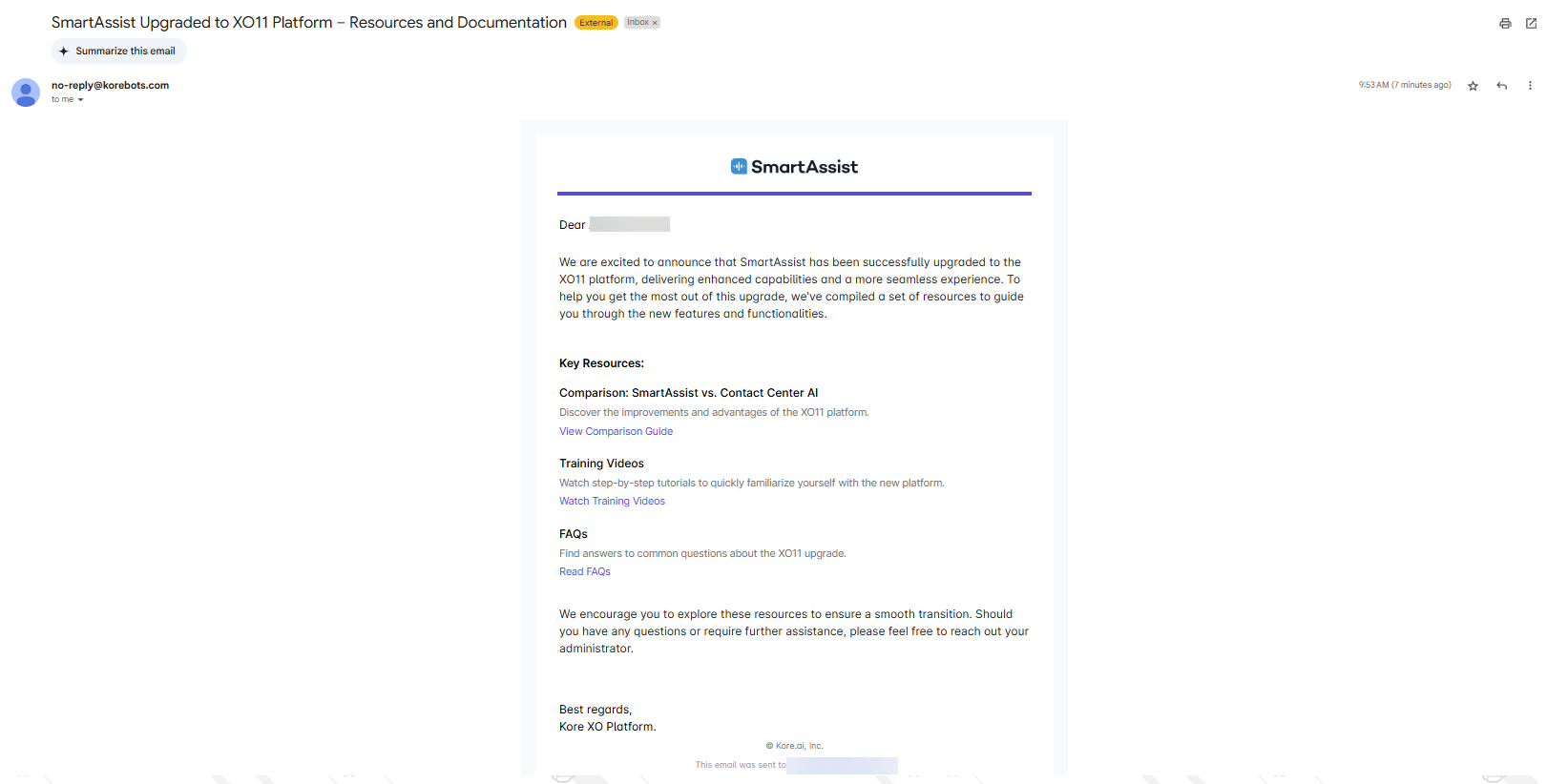
- A success message is displayed. In XO11, the SmartAssist instance bot is upgraded to an app.
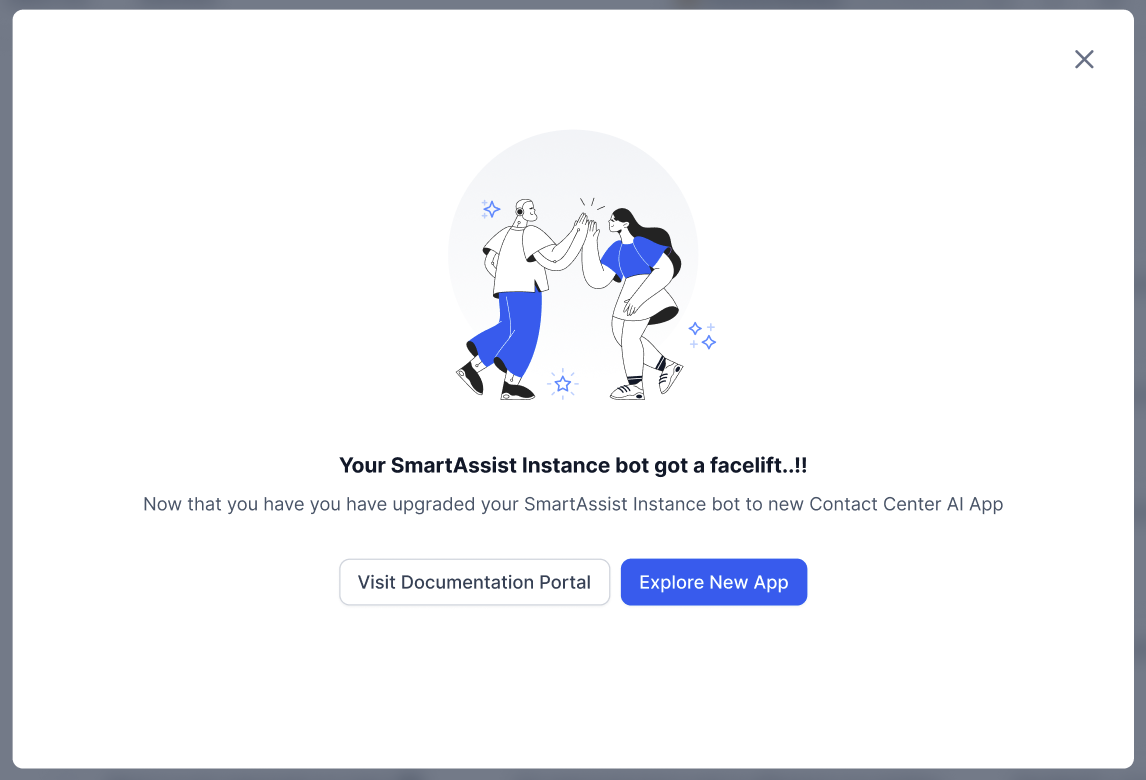
Upgrade Failure
If there is an error during the upgrade, the system stops the upgrade and instantly auto-reverts it.
- An error notification appears on the upgrade window.
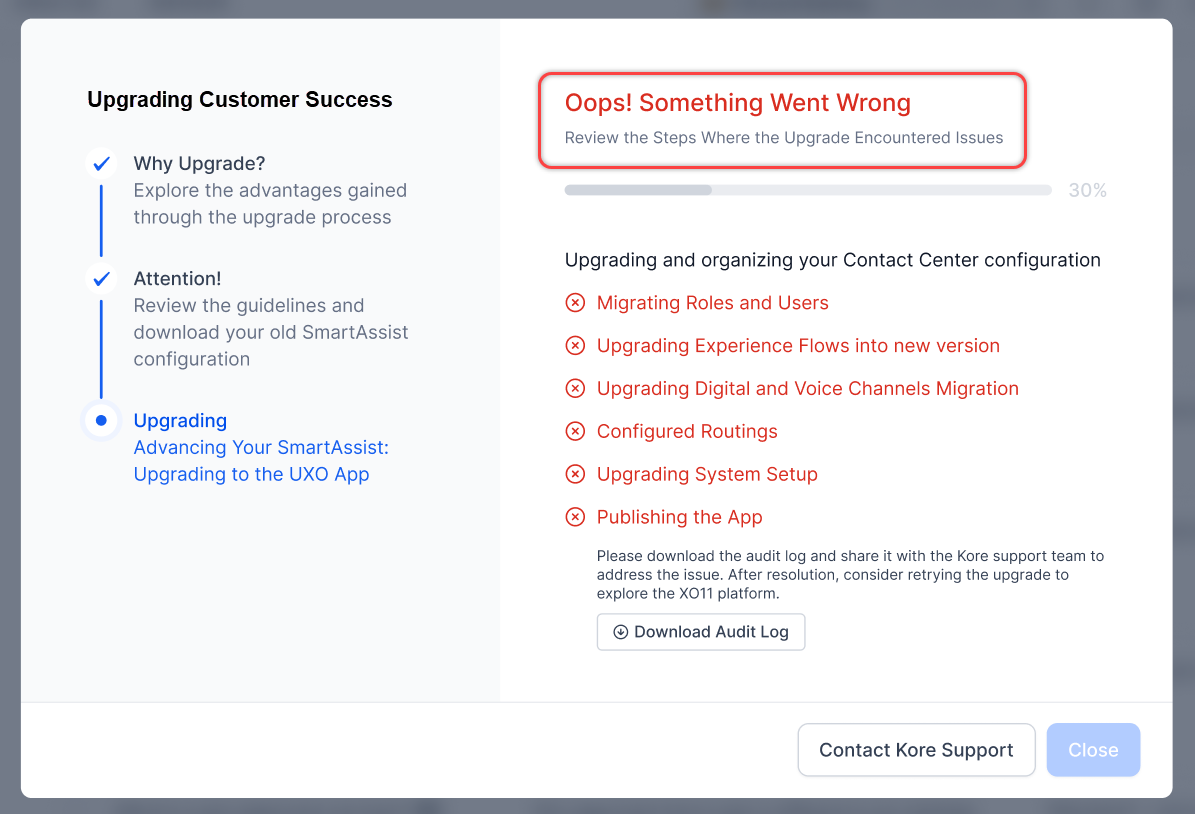
- The upgrade process is auto-reverted highlighting the steps where issues occurred during the upgrade.
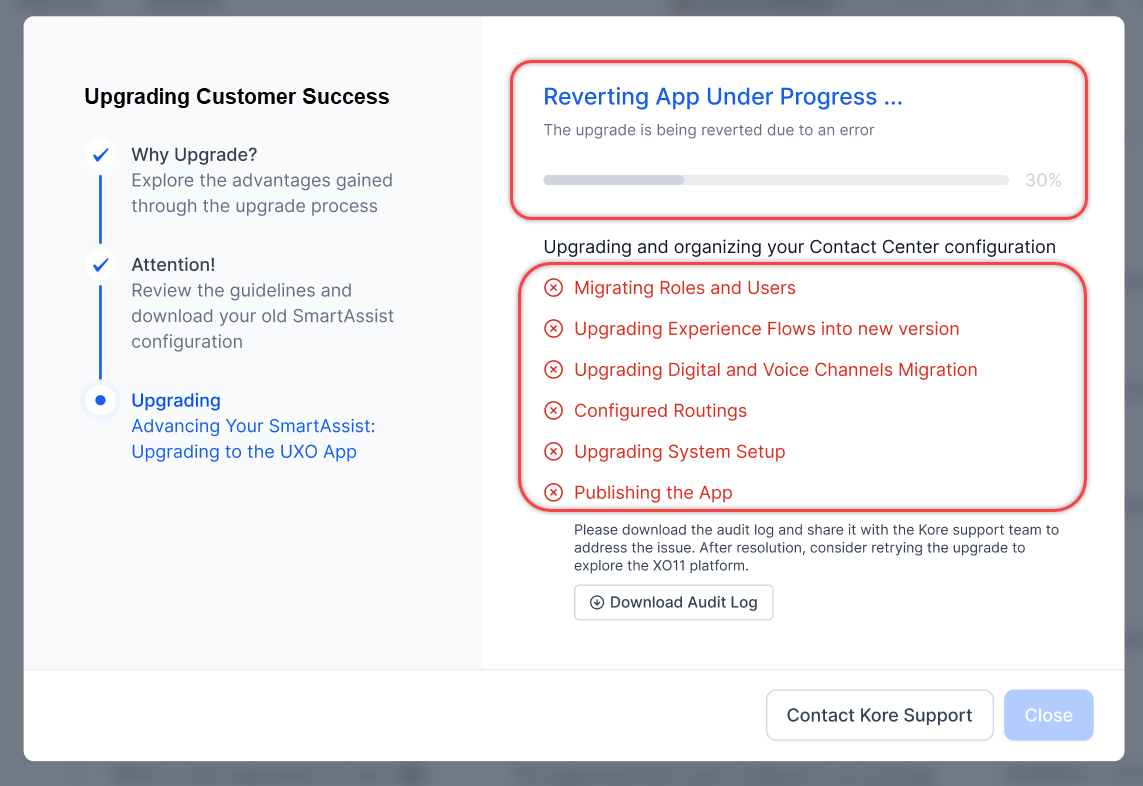
- Click the Download Audit Log to download the .CSV file, share it with Kore Support for further assistance, and click Close.
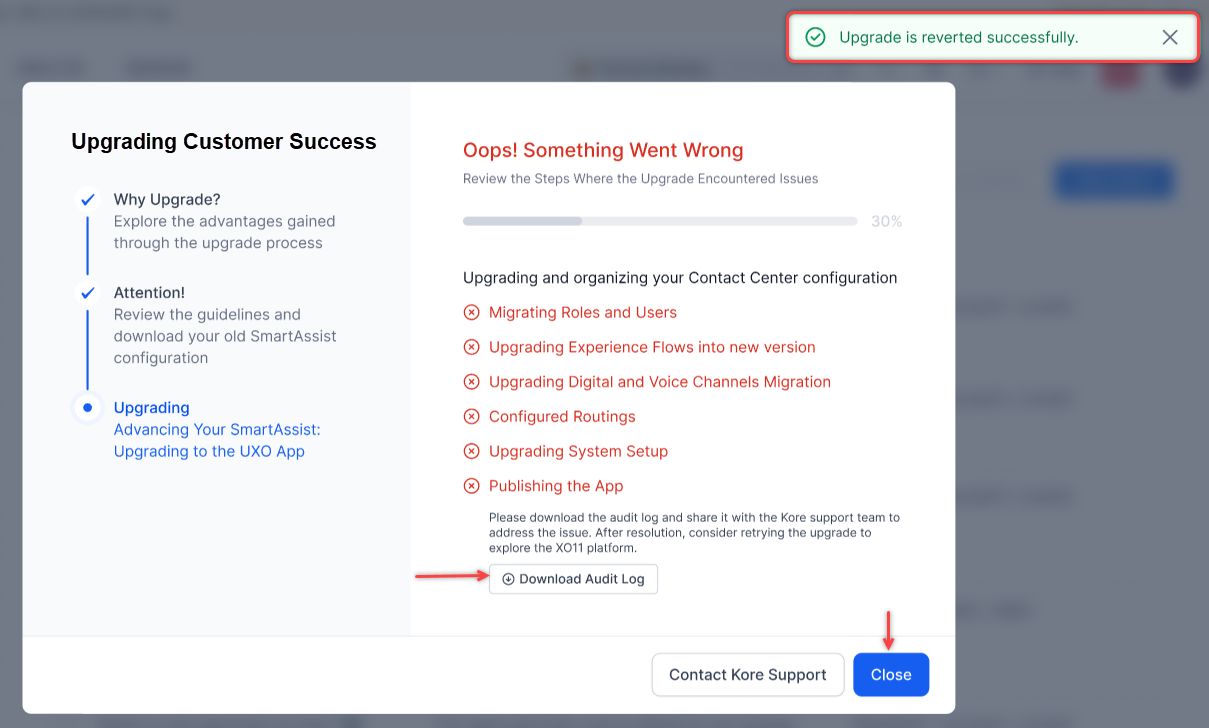
You will be redirected to the XO11 home page.
Post Upgrade Journey
License Migration
SmartAssist License is seamlessly migrated for existing SmartAssist Enterprise accounts to the XO11 platform by automatically provisioning predefined module-specific licenses. The License Migration specifically manages the automatic enablement of appropriate license tiers for Contact Center AI, Automation AI, Search AI, and Agent AI modules based on the customer’s existing SmartAssist configuration and usage patterns.
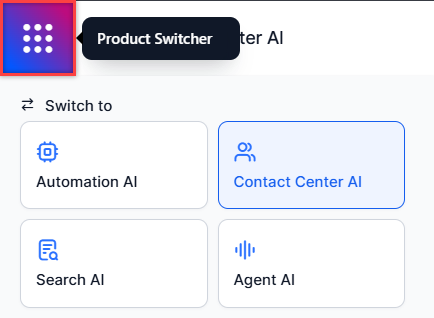
The modules can be accessed on the XO11 platform by clicking the Product Switcher at the top left corner.
Upgrade of Instance Bot and Child Bot to XO11
- Enterprise licenses from SmartAssist are automatically analyzed and converted into equivalent module-specific licenses on the XO11 Platform.
- The system provisions new licenses across four distinct AI modules based on the customer’s previous usage and configuration:
- Contact Center AI
- Automation AI
- Search AI
- Agent AI
- The license conversion process is integrated into the broader upgrade framework to ensure uninterrupted service access for customers during the transition.
Upgrade Access Matrix
Enterprise Standard
App Owner
- Default landing: CCAI flows and channels page.
- Access rights:
- Contact Center AI: Full access (excluding Campaigns, Case Management, and Quality Management).
- Automation AI: Full access.
- Search AI: Basic RAG access.
- Agent AI: Basic access.
Supervisor_BotName
- Access is limited to CCAI.
- No access to Automation AI, Search AI, or Agent AI.
- Data Restrictions: Monitor access is limited to supervised queues.
- Available features: Monitor dashboard without queue restrictions.
Agent_BotName
- Access is limited to CCAI.
- No access to Automation AI, Search AI, or Agent AI.
- Landing page: Agent Console.
- Data access: Limited to own interactions.
- Available features: Agent Console, Interactions Dashboard, My Dashboard.
CustomRole_BotName
- Access is based on configured permissions.
- If granted, include Automation AI access alongside CCAI.
- Landing page determined by permissions:
- Flow Management permission → Flows and Channels
- Monitor permission → Monitor
- Agent Console permission → Agent Console
Non-Enterprise
App Owner
- Default landing: CCAI flows and channels page (trial version).
- Access rights:
- Contact Center AI: Full trial access (excluding Campaigns, Case, and QM).
- Automation AI: Full trial access.
- Search AI: Basic RAG with “Try Now” option.
- Agent AI: Basic access is available with the “Try Now” option.
Other Non-Enterprise Roles
- Similar restrictions as Enterprise Standard, but in trial mode.
- Supervisor and Agent roles are limited to CCAI trial access.
- Custom roles follow the permission-based access model.
Automation Bots Upgrade
Enterprise Automation Bots
- App Owner:
- Default landing: Automation AI flows page.
- Full access to Automation AI.
- Full access to CCAI.
- Basic RAG access for Search AI.
- Basic Agent AI access.
- All other roles (Supervisor, Agent, Custom): No access.
Non-Enterprise Automation Bots
- App Owner:
- Default landing: Automation AI flows page (trial version).
- “Try Now” access to Contact Center AI.
- The trial version of Search AI with Basic RAG.
- “Try Now” access to Agent AI.
- All other roles (Supervisor, Agent, Custom): No access.
Data Access Restrictions
- Supervisors: Limited to assigned queue data.
- Agents: Limited to own interaction data.
- App Owners: No data restrictions.
- Custom Roles: Based on assigned permissions.
Roles and Permissions
Roles in SmartAssist are mapped at the instance bot level. After the upgrade to XO11, these roles, which include default and custom roles, are mapped at the workspace level.
| SmartAssist Role | XO11 CCAI Role |
| Instant bot creator in SmartAssist | App Owner |
| Agent | Agent + botName |
| Supervisor | Supervisor + botname |
| Custom roles | Custom roles + botName |
Roles in Contact Center AI have additional access, for details refer to Role Management.
SmartAssist vs Contact Center AI Documentation Links
| SmartAssist | XO11 Contact Center AI Module |
|---|---|
| Experience Flows |
|
| Waiting Experience | Moved to Contact Center AI > Waiting Flows. Learn more. |
| Use Cases | Deprecated. Existing Q&A use cases are moved to Answers > Knowledge AI > FAQs. Learn more.
Existing conversation use cases are moved to Automation > Use Cases > Dialogs. Learn more. Further, the ability to classify whether a Conversation Use Case is meant to be used for automation, deflection, or agent transfer is deprecated. Users are requested to modify dialogs to include agent transfer nodes manually. |
| Skills | Moved to Contact Center AI > Skills. Learn more. |
| Queues | Moved to Contact Center AI > Queues. Learn more. |
| Hours of Operation | Moved to Contact Center AI > Hours of Operation. Learn more. |
| Default Flows | Deprecated. Customers are advised to use conditional flows for no agents available & out of hours. Learn more. |
| Users | Moved to Contact Center AI > Agent Management > Agent Groups. Learn more. |
| Agent Groups | Moved to Contact Center AI > Agent Management > Agent Groups. Learn more. |
| Agent Settings | Moved to Contact Center AI > Agent Management > Agent Settings. Learn more. |
| Role Management | Moved to Users > Access Controls > Role Management. Learn more. |
| Agent Status | Moved to Contact Center AI > Agent Management > Agent Status. Learn more. |
| Service Level | Moved to Contact Center AI > Performance Management > Service Level. Learn more. |
| Performance Management Settings | Moved to Contact Center AI > Performance Management > Settings. Learn more. |
| Channels > Voice | Moved to Flows & Channels > Channels > Kore Voice Gateway. Learn more. |
| Channels > Chat | Moved to Flows & Channels > Channels > Digital. Learn more. |
| Channels > Email | Moved to Flows & Channels > Channels > Digital. Learn more. |
| Agent Transfer > Voice | Moved to App Settings > Integrations > Voice. Learn more.
Note: Additional settings may be required. |
| Agent Transfer > Chat | Moved to App Settings > Integrations > Chat. Learn more.
Note: Additional settings may be required. |
| Agent Console | Moved to Contact Center AI > Console. Learn more. |
| Monitor | Moved to Contact Center AI > Console> Monitor. Learn more. |
| Surveys | Moved to Contact Center AI > Configurations > Surveys. Learn more. |
| Agent Forms | Moved to Contact Center AI > Configurations > Agent Forms. Learn more. |
| Dispositions | Moved to Contact Center AI > Agent Management > Dispositions. Learn more. |
| Languages & Speech | Moved to Contact Center AI > Configurations > Languages & Speech. Learn more. |
| Standard Responses | Moved to Contact Center AI > Configurations > Response Templates. Learn more. |
| Interactions | Moved to Contact Center AI > Analytics > Interactions. Learn more. |
| Queues & Agents | Moved to Contact Center AI > Analytics > Queues & Agents. Learn more. |
| Reports | Moved to Contact Center AI > Analytics > Reports. Learn more. |
| API Setup | Moved to App Settings > Dev Tools > API Scopes. Learn more. |
| Widgets | Moved to Contact Center AI > Configurations > Widgets. Learn more. |
| AgentAssist settings | Moved to the AgentAI module. Learn more. |
| SearchAssist | Moved to the AgentAI module. Learn more. |
| Advanced settings | Moved to Contact Center AI > Configurations > Advanced Settings. Learn more. |
